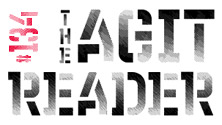
Llanos
self-released
It was a few weeks ago, rummaging through the stacks at my local record store, Used Kids, that I noticed a lonely cardboard box filled to the brim with garishly designed, homemade CDRs by a myriad of anonymous basement crawlers. It had a sign attached proclaiming “Noise sale—everything $1.” If that’s not a death knell for the genre’s once gloried boom, I don’t know what is. But those “kids” had to go somewhere. Had they given up music completely and taken to studying holography or Eastern mysticism? Or did they all simply grow up and ditch the Merzbow-aping, improv-reliant caterwauling that was so en vogue mid-decade?
Or are they naturally shifting towards new horizons, like Columbus’ Mike Shiflet? It’s hard to measure the subversive influence that Shiflet and his now-defunct, but once flourishing, Gameboy Records, has held over this crowd. He always seemed somewhat above it all, not in an elitist sense, but in the understanding that Shiflet was operating on a different plane, one where his tools were texture and drone and harsh crescendos, instead of making noise for noise’s sake. A lot of those kids have moved on and a huge harbinger of that shift was found in Emeralds’ progressive servitude towards melody and structure—coming out of 2010 as a new awakening in psychedelic music. Shiflet looms in that rank.
With Llanos, his new solo album, Shiflet has, to a degree, followed the lead of those perpetually stoned lads up north. The tools are still the same, only refined, used for a deeper, more tangible purpose. As such, the album, as always released by his lonesome, is said to be “conceptually centered on a single evening in a field.” Not sure if he’s referring to Antrim Park (the first track is titled “Antrim” mind you), but regardless, it does reverberate like a night lying on one’s back in a wide-open slice of nature, surrounded by the terrifying buzz of the suburbs and the distant glow of the city downtown. But let’s not go overboard quite yet. Llanos is not destined for the pop charts, but neither is it deigned to find refuge in a $1 box of anonymous noise discs. It’s still “noise” by definition—if you define “noise” as a somewhat amorphous structure, looking to form physiological aberrations in the listener rather than be a catchy tune. For Shiflet, evoking mood is part of that definition, and by adhering a certain singular feeling of awe to his already bone-chiling, teeth-chattering, face-melting, sooth-saying layers of droning bristles, he is transcending past lives.
In the introductory set-piece, “Antrim,” and on the title track, Shiflet uses noise as ambience and ambience as a canvas to start carving out melodies, no matter how insignificantly they may pulsate in the background or how quickly they tend to evaporate under the stress of static and extraterrestrial interference that gets picked from the night sky. One does get the feeling they’re engulfed in nature, even if it’s complete electricity that’s constructed the music. “Pink Meadows” could be considered classic Shiflet really. In 12 minutes of circulating kinetics and hallucinatory spatial movements, he forms a bridge between the old and new. In stark contrast to the almost meditative gaze of “Pink Meadows,” “Sunbathers” is like flipping over the boulder to reveal a subterranean metropolis of worker drones and half-formed labyrinths. The track is perhaps the closest Shiflet has come to actually riffing—laying on the doom-trip in thick, sludgy chords while trying to compete with the endless layers of industrial clatter mindlessly idling on the surface. This carnal indulgence sounds cathartic, though it’s almost unnoticeable, with the listener having to descramble what’s going on in the foreground to even catch a glimpse of the composer with his guitar. “Sunbathers” is the time in this “evening” when the stars light up, the endorphins rage, and the buzz peaks. It is the sound your subconscious makes trying to collect it all. “Gunpowder (For Raglani),” the finale, is where the two streams of Shiflet’s evolution co-exist side by side, a convergence Shiflet explains in the notes as where “the noise and the music make peace.” These are tones that have always been there in the past, just never this crystal clear and never this perpendicular. Llanos might read as something quite pedantic, maybe even a bit self-serving, but you shouldn’t let words get in the way of this record. Llanos is pure nature: radiation and wind, sunbeams and darkness. Noise or not, Shiflet’s mammoth tones and underlying textures speak for themselves. There is no denying that you’re dealing with a master here, and his vision is rare, especially among those aforementioned kids.
Kevin J. Elliott
PRIMITIVE FUTURES
Introducing... Slug Guts
Hype Williams, Find Out What Happens When People Stop Being Polite, and Start Gettin Reel
Big Troubles, Worry
Sharp Ends, Sharp Ends
The Beets, Stay Home
CDR Singles Club Back from Hiatus
Hank IV, III
Idle Times, Idle Times
Dan Melchior und das Menace, Visionary Pangs
Pregnant, Pregnant
Tyvek, Nothing Fits
Introducing... Deathly Fighter
Purling Hiss, Hissteria
October Harvest
